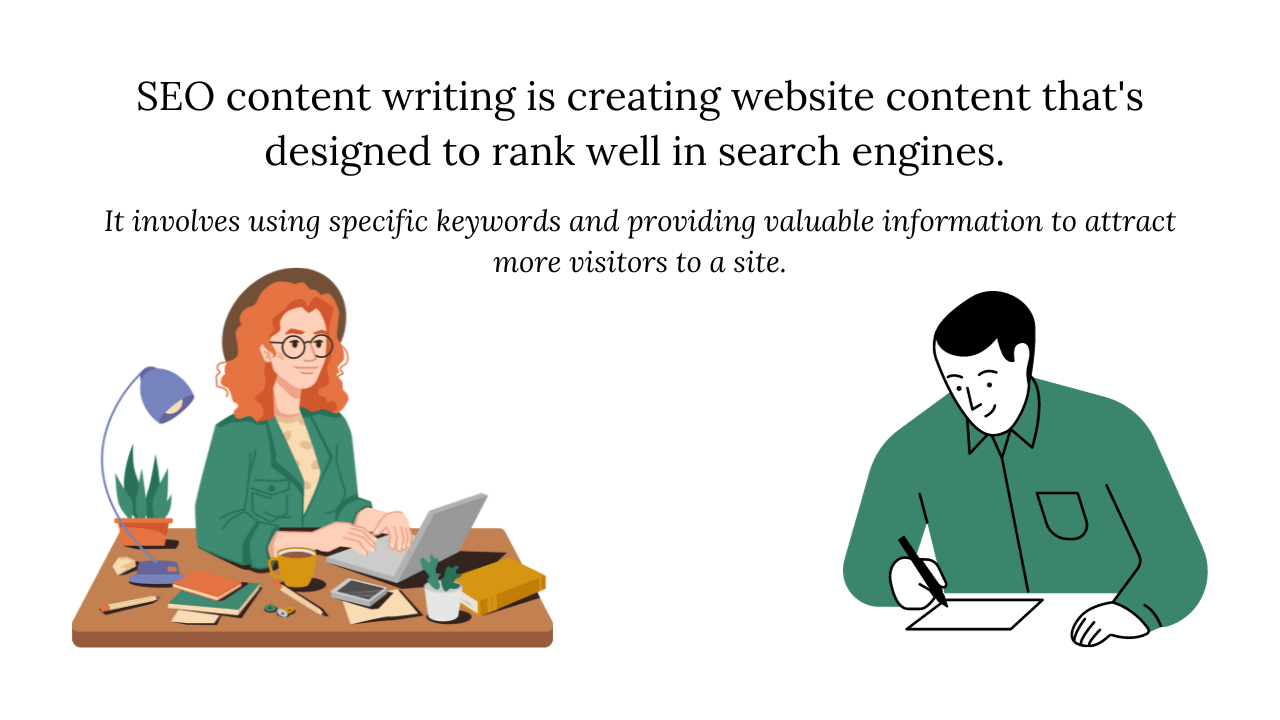In today’s digital age, having a strong online presence is crucial for businesses and individuals alike. Whether you’re a small business owner, a blogger, or an aspiring writer, understanding the art of SEO (Search Engine Optimization) writing can significantly impact your success online. So, what is SEO content writing, and how can you create content that not only engages your readers but also ranks high on Google? In this comprehensive guide, we’ll explore the world of SEO writing, share valuable tips, and equip you with the knowledge to write blog posts that shine on search engine result pages.
What Is SEO Content Writing?
Before diving into the tips, let’s clarify what SEO content writing actually means. SEO content writing is the practice of creating online content that is optimized for search engines like Google.

The goal is to create valuable, informative, and engaging content that not only resonates with your target audience but also ranks well in search engine results pages (SERPs). In essence, SEO content writing is the bridge between producing quality content and ensuring it’s discoverable by people searching for relevant information.
Tip 1: Keyword Research – The Foundation of SEO Writing
Keywords are the heart of SEO writing. They are the words and phrases people use when searching for information online. To write content that ranks on Google, you must start with thorough keyword research. Here’s how to do it:
Conduct Keyword Research
- Use Keyword Research Tools: Tools like Google Keyword Planner, Ahrefs, or SEMrush can help you find relevant keywords in your niche.
- Competitor Analysis: Analyze your competitors’ content to identify the keywords they are ranking for. This can provide valuable insights.
- Long-Tail Keywords: Don’t just focus on broad keywords; long-tail keywords (phrases with three or more words) can be less competitive and highly targeted.
Keyword Selection
Once you have a list of potential keywords, it’s time to choose the most suitable ones for your content. Consider the following factors:
- Relevance: Ensure the keyword is relevant to your topic.
- Search Volume: Aim for keywords with a reasonable search volume. Extremely high-volume keywords may be too competitive for new websites.
- Competition: Evaluate the competition for the chosen keyword. Some keywords may be easier to rank for than others.
- User Intent: Think about the intent behind the keyword. Is the searcher looking for information, a product, or a solution to a problem?
Tip 2: High-Quality Content – The SEO Content Writer’s Best Friend
Once you’ve identified your target keywords, it’s time to create high-quality content around them. Remember, your goal is to provide value to your readers. Here are some key points to keep in mind:
Write Informative and Engaging Content
- Originality: Avoid plagiarism at all costs. Your content should be unique and offer fresh insights or perspectives.
- Value: Focus on delivering valuable information that answers the reader’s questions or solves their problems.
- Engagement: Write in a conversational tone to keep your readers engaged. Use anecdotes, examples, and relatable language.
- Structure: Organize your content into clear sections with headings and subheadings. This makes it easier for readers to skim and find the information they need.
Optimize for Readability
- Paragraph Length: Keep paragraphs short and concise. Walls of text can be daunting for readers.
- Bullet Points and Lists: Use bullet points and numbered lists to break up information and make it more digestible.
- Use Images and Multimedia: Incorporate relevant images, videos, and infographics to enhance the visual appeal of your content.
- Mobile Optimization: Ensure your content is mobile-friendly. Many users access the internet through smartphones.
Tip 3: On-Page SEO – The Technical Side of SEO Writing
On-page SEO refers to the technical optimization of your content to improve its search engine ranking. It involves various elements within your web page or blog post. Here’s how to implement on-page SEO effectively:
Optimize Title Tags and Meta Descriptions
- Title Tags: Craft compelling and descriptive title tags that include your target keyword. Keep them under 60 characters to ensure they display correctly in search results.
- Meta Descriptions: Write concise meta descriptions that provide a preview of your content. Include your keyword naturally.
Use Header Tags
- Header Tags (H1, H2, H3, etc.): Use header tags to structure your content. The H1 tag should contain your main keyword and serve as the main title of your post.
- Hierarchy: Maintain a clear hierarchy of headers, with H2 tags for subheadings and H3 tags for subsections, and so on.
Internal and External Links
- Internal Links: Link to other relevant pages or blog posts within your website. This helps improve user engagement and navigation.
- External Links: Include authoritative external links to back up your claims or provide additional resources. This can boost your content’s credibility.
Optimize Images
- Image Alt Text: Add descriptive alt text to your images. This not only improves accessibility but also provides another opportunity to include keywords.
Tip 4: Regularly Update and Maintain Your Content
SEO is not a one-and-done task. Search engines favor fresh and updated content. Here’s why and how you should regularly maintain your content:
The Importance of Updating
- Relevance: Information can become outdated over time. Regular updates keep your content relevant and accurate.
- User Experience: Updated content provides a better user experience, which can lead to more engagement and shares.
- Search Engine Ranking: Google and other search engines reward websites that consistently offer fresh and relevant content.
Update Old Posts
- Keyword Refresh: Periodically revisit old blog posts and update them with new keywords or information.
- Add Value: Enhance the content with additional insights, statistics, or case studies.
- Broken Links: Check for broken links in your older content and replace them with working ones.
Tip 5: Promote Your Content
Creating exceptional SEO content is only part of the equation. To maximize your content’s reach and impact, you need to promote it effectively:
Social Media Promotion
- Share on Social Media: Share your blog posts on platforms like Facebook, Twitter, LinkedIn, and Instagram. Use engaging captions and hashtags.
- Leverage Visual Content: Create eye-catching visuals, such as custom images and infographics, to accompany your social media posts.
Email Marketing
- Newsletter Campaigns: If you have an email list, send out newsletters featuring your latest blog posts to keep your subscribers engaged.
Collaborate and Outreach
- Guest Blogging: Contribute guest posts to other websites in your niche. This can help you build backlinks and establish authority.
- Influencer Outreach: Collaborate with influencers in your industry to share your content with their followers.
Monitor and Adapt
- Analytics: Use tools like Google Analytics to track the performance of your blog posts. Monitor traffic, engagement, and conversion rates.
- Adjust Strategies: Based on your analytics data, adjust your content promotion strategies to focus on what works best.
Conclusion
In the world of SEO content writing, mastering the art of creating blog posts that not only inform and engage but also rank high on Google is a valuable skill. By conducting thorough keyword research, producing high-quality content, optimizing for on-page SEO, regularly updating your content, and promoting it effectively, you can set yourself on a path to online success. Remember, SEO writing is an evolving field, so staying updated with the latest trends and algorithms is key to long-term success. Happy writing, and may your blog posts shine on the first page of Google!








